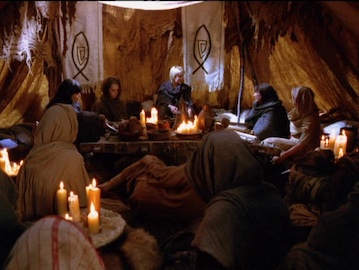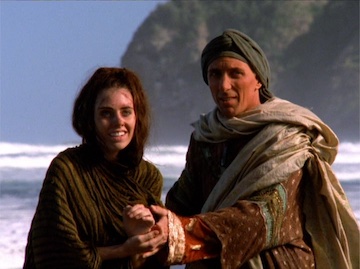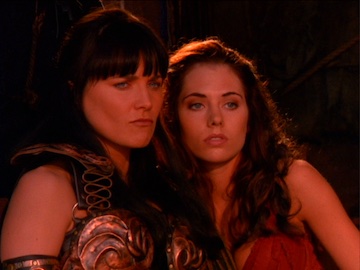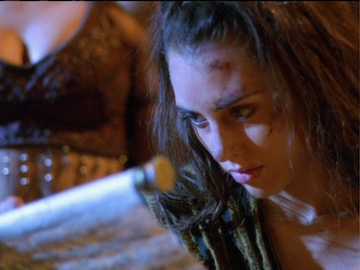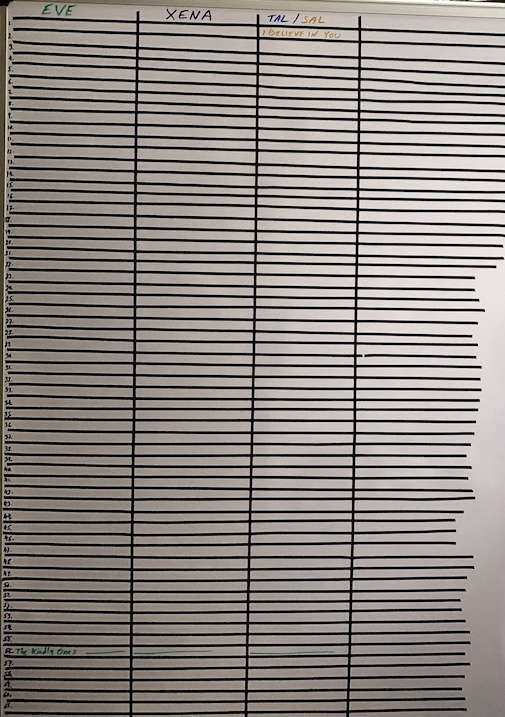“It’s all falling apart!” — [rebel insurgent Tivik]
I was a bit confused by this movie when it was first released in 2016. I enjoyed it, as Imperial Droid K2SO might say, in a “vague and unconvincing way.” But it was hard to fully appreciate at first glance, for a number of reasons.
First, most of the characters are new, their stories are told in bits here and there, and if you don’t immediately memorize their first and last names, you won’t follow who’s talking about whom. Assuming you can tell them apart, that is. Except for a few, it’s not clear what their backstory is, what they want, and where they want to go, unless you pay attention to small clues planted throughout, which you probably won’t, the first time you’re viewing it.
Second, we have the same problem with the locations. The story cuts back and forth from many locations, all on different planets, and often with little warning. It’s not always clear who came from where, and when they’re meeting for the first time, and where they’re going next. The names won’t help you because most of them you’ve never heard before, except for a few you almost certainly forgot from previous films seen decades earlier.
Third, I was thrown by those elements that were familiar. Not just the countless shout-outs to previous films, with cameos of minor characters we’ve grown familiar with over many viewings, nor countless shots that visually echo past iconic images. There’s the return of Grand Moff Tarkin, Senator Mon Mothma, the commander of the Rebel Fleet, and others. Like with Darth Vader himself, you’re left wondering who’s human, who isn’t, are they convincing, are they in keeping with their previous appearances or are we going to watch beloved icons misused for the sake of the unknown cause this film serves?
so, it was a few years later when I saw “Rogue One” on Netflix and decided to give it another try. I’m very glad I did, and I wish we’d see more of this side of the Force.
It takes a few viewings to orient yourself with these characters and their locations, but you start to figure out for yourself who they are and what they want. There’s no obvious journey of the hero on display, no grand destinies, and no uncanny displays of Force “magic.” It’s all on a human scale, featuring humans who don’t trust each other and reveal only what they need to, when they have to. Regardless of location, whether in space or not, everything feels grounded and connected. The technology in this story seems to harken back to Star Wars’ original vision of using World War II era films as reference, with the battle scenes reminiscent of Vietnam War footage (Star Wars was originally conceived as an allegorical commentary on the Vietnam War, before George Lucas decided that escapism was in short supply in the 1970s, and embraced the old movie serials instead). None of it looks computer generated, not even the buildings, the fantastical landscapes, or the spaceships. You’ll notice that the smaller ships leave marks when they take off, occasionally knocking people over. Even in space, there’s mass and shadow, and a ship, or even a planet, might emerge from the shadows when approached. When Darth Vader does make his grand appearance with a light saber, there’s no dancing about. He hacks at his opponents like weeds and his fist seems just as deadly, brandished on its own.
The film’s main villain, Orson Krennic, is perhaps the first character of the Imperial government who seems to have an agenda of his own, and capable of real human interaction at some point in his life. We see glimpses of an office party with him, Galen and his daughter Jyn. Though hardly a nice fellow, he’s recognizably human, and his evil is just as humanly proportioned. Suffice to say, he finds himself dealt out of the game by truly ruthless competitors who sacrificed their humanity long ago, and with his own single-minded ambition aptly rewarded, as Darth Vader predicted.
The story unifies around the main character, Jyn Erso, who’s scarred by the experience of abandonment by everyone charged with her protection, growing up. She’s spent her life getting kicked around the grey areas of the Rebellion. The dual nature of Darth Vader, man and machine, seems to define this world. Her father is a rebel who builds the Death Star, her guardian, Saw Guerrero, an insurrectionist whose bloody encounters with the Empire have left him half machine and wheezing into a breathing tube, much like Vader. When he reunites with Jyn, there’s a shot of his metal feet walking along a metallic floor grid, that very much resembles Vader’s march to Princess Leia’s cell in “A New Hope.”
This view of the Rebellion is very different than what we saw in “A New Hope,” where Han Solo was the only rogue in sight. The difference is accounted for, I assume, by the fact that we’re seeing the Rebellion coming together as a formal entity for the first time. Home grown uprisings now seem to have come together under a Senator’s leadership, but it’s a shaky alliance. As one of Guerrero’s men tells Rebel Intelligence Officer Cassian Andor, “It’s all falling apart.”
The Senator, Mon Mothma, states at the beginning what she has to offer: a “chance to make a fresh start.” She has no power to grant it, or to enforce her will. Agreements are democratically arrived at, or not at all.
Fortunately, the democratic spirit is strong with Jyn, thanks to the crew she picks up on her travels to the Rebel Alliance Headquarters. George Lucas drew inspiration from the films of Akira Kurosawa, and there is a big nod to films like “The Seven Samurai” when the action moves to the last Jedi temple of Jedha. It seems this place may have been the birthplace of Jedi philosophy, and we see signs of ancient ruins suggesting that, such as an enormous Jedi statue half buried and seemingly asleep in its deserts. The only remains of Jedi culture lie with its now-unemployed protectors, who, like the Ronin in “The Seven Samurai,” are without masters or teachers.
We’re greeted in Jedha by blind Chirrut Imwe’s wish, “May the Force of others be with you!” It’s not clear if this is an ancient version of the phrase we’re all used to, or if it’s a garbled version from a man who never formally trained as a Jedi (there was no one to train him, growing up), but it’s very well suited to a film that will have to get by without any real Jedis, or “Force Magic.” He does seem to possess some kind of power as he chants his prayers, but it’s not clear if this is the Force working through him, or he’s just over-confident and very lucky. As he will insist, “The Force did protect me!”. “I protected you,” his guardian friend and Force apostate, Baze, corrects. But they’re both right: The Force of others protected him, as he predicted. This Force protects the others as well, until each does what they can, then trust others to carry on.
The final battle is a passing of responsibility to more familiar characters, but the end of these characters we’ll never see again does not seem tragic. Not just because of their worthy cause, but because they all get what they’re looking for. Baze is brought back to his faith, and reunion with his friend; Bodhi, the Imperial pilot defector, gets to do more than just keep the engine running, he’s able to fulfill the dream of his mentor, Jyn’s father. Cassian, who, like Jyn, found himself part of the Rebellion at an early age, and a killer who, unlike Han, shoots first, has his lifelong faith in the Alliance repaid. Even the petulant droid, K2SO (who, like Bodhi, has a few wires loose due to some “reprogramming”), finally gets to wield a blaster. And Jyn, whose childhood memories echo with the words “protect,” and “trust,” is capable of doing both by the end, and has found those worthy of it. “I’m not used to people sticking around when things go bad,” she tells Cassian. “Welcome home,” he replies. Chirrut tells her on their first meeting that “The strongest stars have hearts of kyber!” Her necklace from her mother bears a kyber crystal, and from her father, the nickname Stardust. The result of her mission will end with the Death Star returned to dust among the real stars, though she last sees it perched serenely among the clouds, like a natural part of the heavens.
Her destiny, it seems, was perhaps foretold after all, as much as Luke Skywalker’s was, except it grew organically out of her experiences, and the hand-off of her efforts to Princess Leia, whom she never meets, doesn’t seem forced, but a natural end result. As she says in her attempt at a “pep talk” to the Rogue One crew, success is doing the first thing, then figuring out the next thing, each step of the way, and you need to have faith you might reach the end. This isn’t the vision of a genetically elite Jedi hero; It’s a faith in a democratic process that doesn’t always work smoothly, but accomplishes its mission by casting its net and its hopes widely, with the Force of others, a power that we’ll also see wielded elsewhere, such as the final scenes of “Return of the Jedi.” This film lacks the high mythic purpose of other Star Wars films, or the soaring victory themes, and after three grim prequels detailing the shortcomings and cynical abuse of the democratic process, it’s strangely empowering, and a relief, to see it affirmed here, though it’s the last thing I expected from a crew that styles itself “Rogue One.”
